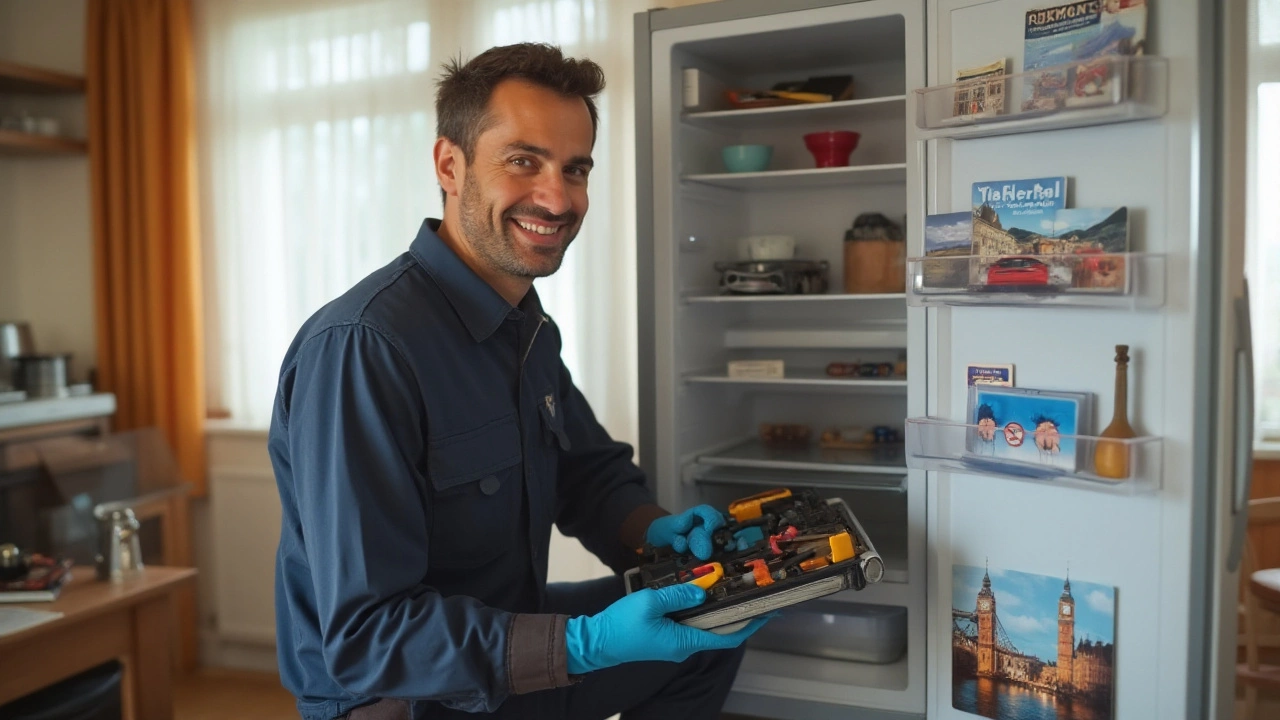Refrigerators have quietly become the heart of our kitchens, keeping our food fresh and drinks cold. But when they start acting up, it can be a real test of patience. Understanding what typically goes wrong can save both time and money.
Whether it's the thermostat not doing its job, a compressor that's decided to take a break, or simply air not flowing as it should, knowing these common culprits is half the battle. And don't worry, there's plenty you can do to keep your fridge humming along happily—or at least know when it's time to call in the experts.
Here's a look at some of the most common fridge problems you might run into and a few handy tips on how to fix them or prevent them in the future.
Thermostat Troubles
In the world of fridge repair, the thermostat plays the role of the orchestra conductor, keeping everything in sync and the temperature just right. When it decides to slack off, your fridge can either get too warm or too cold, turning your once perfect produce drawer into a mini tundra or a sad warm corner. A malfunctioning thermostat is often one of the primary suspects when your refrigerator stops cooperating. It's a small component, generally residing behind a plastic cover inside the fridge or sometimes on the back, and is deceptively simple in its purpose but complex in its impact if it goes awry.
The thermostat is responsible for sensing the temperature within the fridge and signaling the compressor to maintain the desired level of coolness. If the thermostat isn't functioning properly, it could fail to signal the compressor when needed, leading to inefficient cooling and potentially spoiling your stored goods. This can happen for a variety of reasons. Sometimes, wear and tear take their toll, or it might be a victim of electrical glitches. In many cases, it's the dirt and grime that accumulates over time, creating a barrier to accurate temperature reading.
Before writing off your fridge as a lost cause, there are a few troubleshooting steps you can take to ensure that your thermostat is the real culprit. First, check the control setting to make sure someone hasn't bumped it into an incorrect position. It's surprisingly common for a cleaning session or a curious toddler to accidentally adjust the settings. Additionally, you can perform a continuity test using a multimeter to determine if the thermostat has a continuous electrical circuit; if it doesn't, it's time for a replacement. Remember, safety first: always unplug the fridge before attempting any repairs.
An anecdote in the appliance repair field, often mentioned in hushed tones, is about the repair technician who swore by tapping on the thermostat as a quick diagnostic trick. While this may sound like a bit of folklore, it occasionally jostles mechanical thermostats back to working order, albeit usually temporarily. A more reliable approach is replacement, especially since thermostats are generally inexpensive and relatively straightforward to swap out with some basic tools. It’s a task well within the capabilities of a DIY enthusiast eager to save on repair costs.
"Refrigerators run better and last longer when the thermostat is calibrated correctly," says Jack White, an appliance repair veteran. This seemingly basic component can hold the key to prolonging the life of your trusty fridge.
Routine maintenance can also prevent issues before they sabotage your stockpile of groceries. Cleaning the interior and exterior of your fridge, particularly around the thermostat area, can ensure accurate temperature readings. Dust and grime may not seem like significant threats, but they can interfere with the sensors. Regularly checking the temperature with a separate thermometer helps confirm your fridge's accuracy, a practice that nudges you towards early detection of potential thermostat troubles. So, attention to these minute details upgrades your fridge maintenance game immensely, keeping your refrigerator reliable year-round.

Compressor Challenges
The compressor is the beating heart of any refrigerator, tasked with pumping refrigerant through the coils and helping your fridge maintain that perfect cool temperature. Though fierce and hardworking, the compressor can face numerous challenges over its lifespan. When it doesn’t hum as it should, the entire cooling system is compromised, leading to items in your fridge warming up uncomfortably.
It's fascinating how such a small component can affect the vast expanse of your fridge. It normally works silently at the back of the fridge, but when it begins making strange noises, it’s a clear cue for attention. A constant or very loud humming noise can indicate something's amiss, likely hinting at a malfunction. Equally troublesome is when it stops working altogether, leaving your food to fend for itself. One must not underestimate the power draw dead compressors can cause, leading to eye-watering electricity bills while doing nothing for your perishables.
"When a compressor fails, it's like a concert without the orchestra – all the right pieces are there, but nothing quite works." - Robert Moody, Appliance Specialist
Diagnosing a faulty compressor is not an easy task for the average homeowner. First, check if the fridge's internal temperature is higher than usual, or if it cycles on more frequently. Attempting simple resets can sometimes do the trick—unplugging the fridge for a few minutes and plugging it back in to see if the issue persists. In more serious cases, replacements might be necessary. However, compressor replacements can be quite the expense, often making up a significant portion of the appliance's cost.
Regular maintenance plays a crucial role here. Cleaning the coils, located either behind or beneath the fridge, ensures they work efficiently. This, in turn, eases the load off the compressor. Dust and grime can act as insulators, so removing them allows the coils to expel heat more effectively, keeping everything cool as a cucumber. This care includes maintaining regular defrosting and checking seals to keep the unit energy-efficient and in top condition. And one can't forget about inspecting the fan motors for any obstructions or wear.
A lesson often learned is that preventive measures go a long way. By doing regular check-ups and addressing small hiccups before they escalate, you can dodge a lot of headache related to fridge repair. Recognizing the signs early and acting decisively will not only extend the life of your refrigerator but also make sure it remains a trusty kitchen companion, keeping your groceries fresh and your electricity bill in check.

Ventilation and Airflow
Ventilation is the unsung hero of a refrigerator's inner workings. Without proper air circulation, the fridge can't maintain the consistent temperatures needed to keep food fresh and safe. Imagine it like this: a lack of air movement is like a traffic jam inside your beloved cold box, with cool air unable to travel freely to all corners. This can cause warmer spots, leading to spoiling food or growing bacteria—neither of which you want in your kitchen! Dust and debris can block air vents over time, reducing the efficiency of the refrigerator and compelling the motor to labor more. Maintaining these vents is akin to keeping highways clear, letting the fresh, cold air reach every shelf and compartment.
Regularly cleaning the air vents is a simple yet crucial task that repays enormous dividends. Every few months, unplug the unit and inspect the back and interior vents. Vacuum out any visible dirt or debris and use a damp cloth for trickier spots. Keep a close eye on the coils, usually hiding behind or beneath the appliance, as they play a vital role in heat exchange—messy coils mean poor airflow and higher electricity bills. Additionally, make sure that your fridge isn't crammed with food; it's a common mistake that blocks airflow and forces the motor to work overtime. A well-ventilated fridge not only preserves food better but can also last longer, essentially paying you back for the effort with each passing year.
"A clean fridge is a happy fridge," notes renowned home economist Mary Ellen Pinkham. "Just a little bit of regular maintenance can keep everything working smoothly and efficiently." Her advice resonates, emphasizing how small acts, like dusting off those vents, can reap benefits of greater magnitude.
Interestingly, a poorly ventilated fridge doesn't just impact energy and food safety; it can also mean noise issues. A poorly functioning refrigerator might groan or clatter more loudly as the compressor struggles to keep up with demands. If you're noticing your trusty food box sounding more like a rock concert, consider poor airflow as a potential culprit. Fixing ventilation problems can turn bluff and bluster into quiet efficiency, preserving both food and peace in your kitchen space. Keeping the fridge spaced properly from the wall aids in optimal airflow, so don’t forget to leave a gap for easier breathing! Proper maintenance can be your best friend when it comes to extending the life of your refrigerator and ensuring a harmonious kitchen environment.

Preventative Maintenance Tips
Keeping your fridge in tip-top shape doesn't have to be a daunting task. Regular maintenance can make your appliance run more efficiently and prolong its life. Start by making it a habit to check the door seals occasionally. A common oversight, the seals, or gaskets, can wear out or accumulate food debris over time. This wear leads to cold air leakage, making your fridge work harder than it should. To test them, close a dollar bill or a piece of paper in the door. If it slips out easily, it's time to consider replacing your seals.
Next up, make sure you clean the coils. The condenser coils, usually located at the back or the bottom of the refrigerator, are crucial for proper cooling. Over time, dust and dirt can build up, causing the appliance to run inefficiently and use more electricity. At least once a year, unplug your fridge and gently clean the coils with a vacuum cleaner or a coil brush. Not only will this help your fridge run smoother, but it's also a great house cleaning cardio session!
Regular Temperature Checks
Another key aspect of preventative maintenance is ensuring that your temperature settings are accurate. Most refrigerators have a sweet spot—typically around 37°F for the fridge and 0°F for the freezer. Set it too warm, and you're risking faster food spoilage. Too cold, and you could end up with frozen milk or frosty veggies. Use a thermometer to keep an eye on the internal temperature if your refrigerator doesn't have a digital reading.
Keep It Full, But Not Overcrowded
It might seem a little counterintuitive, but a fuller fridge actually operates more efficiently than an empty one. That said, there's a fine balance as overstuffing can hinder proper airflow, leading to uneven cooling and frozen goods in random spots. Try to keep your appliance about two-thirds full. Utilize shelf organizers to make sure everything has its place and air can circulate freely. “Think of your fridge like a crowded dance floor,” as a refrigeration expert once quipped. “Too packed, and nobody can move.”
To round it all up, preventive maintenance is your fridge's best friend. Keeping an eye on seals, cleanliness, and temperature settings can save a significant amount on energy costs and help avoid untimely breakdowns. And if ever you're in doubt, don't hesitate to call in a professional to give your trusty appliance a once-over. In short, a little planning goes a long way in keeping your fridge running smoothly year after year.


